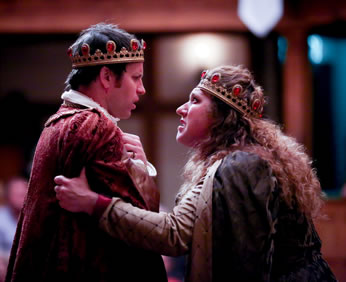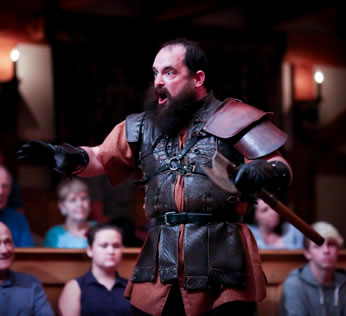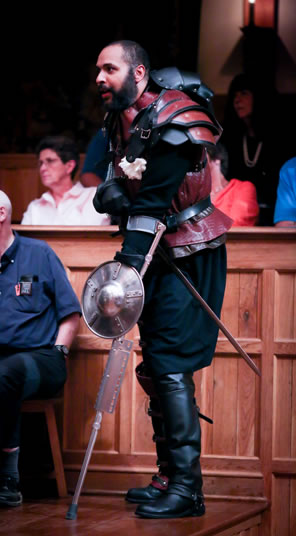The Rise of Queen Margaret (Henry VI, Part 2)
Masterwork in Hand Worth Two in the Making
American Shakespeare Center, Blackfriars Playhouse, Staunton, Virginia
Friday, September 23, 2016, C–6&7 (front middle stalls)
Directed by Jim Warren

Queen Margaret (Allison Glenzer, right) gets a grip on her husband, England's King Henry VI (Chris Johnston), in the American Shakespeare Center's production of William Shakespeare's Henry VI, Part Two (rechristened in this presentation as The Rise of Queen Margaret), at the Blackfriars Playhouse. Photo by Lindsey Walters, American Shakespeare Center.
What's in a name? Both the name of and names in this William Shakespeare play are subject of a comic riff before the play even begins. Once the production gets going, however, this play by any name and containing many names proves to be one of Shakespeare's great masterworks, thanks to the vivid portrayals and verse readings of an American Shakespeare Center cast under the virtuosic direction of Jim Warren.
In a metatheatre sense, this production also serves as an important confluence of past and future in the present for two characters and the actors who play them, a buzz-generating factor for American Shakespeare Center (ASC) fans.
We get started with the cast rocking out on an acoustic rendition of The Who's "Won't Get Fooled Again," Alexander Sovronsky playing the solo bridge on his cricket violin (by the way, at the end of the intermission, the cast also lays down a driving—but still acoustic—take on Stephen Stills' "For What It's Worth" with the audience foot-stomping and fist-pumping along). In the preshow speech, actor René Thornton Jr. welcomes us to the Blackfriars Playhouse, "the world's only re-creation of Shakespeare's indoor theater"—decorated for this occasion with red and white banners, vines of red and white roses climbing the pillars, and two thrones on stage—and the play, The Rise of Queen Margaret. No, that's not the play's real name, says fellow company member John Harrell who has walked on stage, and Thornton admits the play is really called Henry VI, Part Two. "Boring," Harrell says. "The only title that might be more boring would be Henry VI, Part Three." Chalk that up to inside-theater humor: history plays are a tough box office sell, hence Warren rechristening this second installment of Shakespeare's first Henriad.
Harrell goes on to point out that even Henry VI, Part Two, is not the original title used for the play's first quarto publication: The First Part of the Contention Betwixt the Two Famous Houses of York and Lancaster, With the Death of the Good Duke Humphrey: And the Banishment and Death of the Duke of Suffolk, and the Tragical End of the Proud Cardinal of Winchester, with the Notable Rebellion of Jack Cade: And the Duke of York's First Claim unto the Crown. "Spoiler alert," Thornton mutters.
Not quite. Two important names are missing from that digest. One is Margaret, Henry VI's queen; the other is Richard, the Duke of York's younger son, later Duke of Gloucester and eventually king of England, third of that name. When he wrote the play, could Shakespeare have known what a double dose of theatrical force he was about to unleash, one for his time, and one for all time? Watching this production with the benefit of hindsight—ours and through Warren's staging—I sense that Margaret may have taken Shakespeare by surprise, but Richard, already infamously portrayed in Tudor histories, was in the Bard's grand design.
ASC is undertaking Shakespeare's first history tetralogy over the course of four years, concluding with Richard III. The series began last fall with Henry VI, Part One, which Warren rechristened Shakespeare's Joan of Arc. This is the second time ASC has mounted these four plays over a four-year succession. The first was from 2009–2012 in the company's Actors' Renaissance Seasons, replicating Elizabethan production practices wherein the troupe of players, without a director or design team, stage plays using only cue scripts (their parts plus cue lines) with just a few days of rehearsals. That style of production inspired a manic playing of the Henry VI plays, which fit the style of Shakespeare's dawn-of-his-career writing. The process revealed the evolutions of Margaret and Richard (played every year by Sarah Fallon and Benjamin Curns, respectively) culminating in the 2012 portrayal of Richard III that tops my all-time Top 40 Shakespeareances list.
That's a hard act to follow. And last year's Joan of Arc, with a heavy-handed presentation that exposed the play's slap-dash construction and two-dimensional characters, was a comparative stumble.
The Rise of Queen Margaret (nee Henry VI, Part Two) is a giant leap forward, for both Shakespeare and Warren. ASC's co-founder and artistic director, Warren helmed ASC's first show ever, Richard III, and has now directed 127 productions for ASC, including 32 different Shakespeare plays. His text-centric approach gives him a solid handle on characters and situational staging, and he knows how to play the qualities of the Blackfriars Playhouse, with its universal lighting and the audience hemmed in on three sides and even sitting on gallants' stools on stage, but without electronic or digital effects.
His deft handling of Shakespeare has never been so sure-handed as he is with this presentation of Henry VI, Part Two. Counterintuitively, he slows the pace, relying on his cast's expert command of the verse to bring out Shakespeare's 4-D rendering of historical figures and to uncover the play's plot and poetic treasures. Thus, in a play with the largest number of roles in the entire canon, and this production featuring 28 named parts (plus various "rebels, soldiers, servants, guards, messengers") played by a company of just 12 actors, we still can follow who is who, what is what, and why is why (as well as you can figure out why is why when it comes to politicians).
Here we hear the budding fruit in a playwright's career that will, with much proliferation over his next 20 years, feast us another 400 years. "A wilderness is populous enough, so Suffolk had thy heavenly company: For where thou art, there is the world itself, with every several pleasure in the world: and where thou art not, desolation." This is verse fit for a wedding, though spoken by the manipulative, haughty Suffolk—just banished by the king—to the duplicitous Queen Margaret, with whom he has been having an illicit affair. It's tear-inducing poetry counterpoised by Warwick calling Suffolk a "pernicious blood-sucker of sleeping men!"
Ah, the War of the Roses: blooming noblemen bearing thorns. On the Lancaster (red rose) side, there's the Duke of Suffolk (Patrick Earl) with his debonair strut that so enamors the queen, and an entitled arrogance that puts him at odds with the other peers and leads to his death by pirates; the Duke of Buckingham (Sovronsky), steadily loyal to his king and staying above, as best he can, the wrangling of the peers; and the Duke of Somerset (Lauren Ballard), a brash, self-serving social-climber. The very rose hip of the War of the Roses is the rivalry between Somerset and Richard, Duke of York (Harrell), the play's great dissembler (he even tells us this in his soliloquies and asides) who shows outward loyalty to the king while strategizing his way to the throne, pinning his right on a question of primogeniture. His white rose supporters include the Earl of Warwick (Zack Powell), a counterpart to Buckingham in seriousness and loyalty, and his father, the Earl of Salisbury (David Anthony Lewis), an old saw of a warrior with a single-tone morality. "Pride went before, ambition follows him," Salisbury says of Buckingham and Somerset's departure in the play's opening scene.
Each lord wears large roses, white or red, on the lapels of their gorgeous Tudor-era clothes (Costume Designer Jenny McNee spares no thread or stone in dressing these characters in the richest of adornments). This not only helps us identify who is with whom, but we can visually see how the two factions team up to get rid of Humphrey, the Duke of Gloucester (Thornton). Uncle to King Henry, he is the lord protector to the young king and has a public reputation for wisdom and justice. Trying to topple him, the other lords lay charges on him in one scene that, as written, sounds like a modern U.S. presidential debate, especially as we cannot be sure which side is telling the truth (if either).
Thornton plays Gloucester as the duke sees himself, ever loyal and righteous, even berating his own wife, Eleanor (Jessika Williams), for her dream of being queen. Yet, he earns a laugh via the subtle manipulation in his delivery of a line during one of his many arguments with his most mortal enemy—though his uncle—the Cardinal Beaufort (Benjamin Reed playing slimy saintliness): "What, cardinal, is your priesthood grown peremptory? Tantaene animis coelestibus irae? Churchmen so hot? Good uncle, hide such malice; with such holiness [and Thornton shifts rhythmically from preaching to snarkiness] "can you do it?"

David Anthony Lewis is Jack Cade, leading the workers' rebellion against the nobility, known as the Cade Rebellion (and for the line, "First thing we do, let's kill all the lawyers") in the American Shakespeare Center's production of William Shakespeare's Henry VI, Part Two, at the Blackfrias Playhouse. Below, Richard III (René Thornton Jr.) makes his first appearance in the Shakespeare canon. Photos by Lindsey Walters, American Shakespeare Center.
Ironically, Henry VI, Part Two's, most popular character is Jack Cade (Lewis), the leader of a peasant revolt. Part of his lasting fame is a line actually spoken by one of his followers, Dick the Butcher (Powell, as far from the dignity of his Earl of Warwick as you can get): "The first thing we do, let's kill all the lawyers." Cue the audience cheering. Lewis's Cade leads the rebels—a hilarious herd of Monty Pythonesque serfs—with as much volume as obtuse self-promotion, and it is uncomfortably endearing the way he rouses the rebels to slaughter the rich, haughty noblemen of the land (the rebels using the dresses of women sitting on the gallant stools to wipe their blades after each kill). Yet, that "kill all the lawyers" line is part of a greater sense of anti-intellectualism that envelops the rebels, and juxtaposed against the political infighting among the nobles, the parallels to what's happening around us today are cringe-worthy.
In the middle of all this contention is the title character, and Chris Johnston proves powerful enough as an actor to portray Henry's powerlessness, unable to marry his Christian fervor to effective governance or corral his lords. He is king only because he's the great Henry V's son, and though he tries, oh how he tries, he knows how unlike Henry he is, and he's so plagued by self-doubt he cannot navigate through the court politics swirling around him. It's sometimes easy to forget Henry VI is supposed to be the centerpiece of this play, but Warren anchors the proceedings around the king by giving the versatile Johnston the crown and having him enter at play's start, kneel at the front of the stage, and sing the old Irish hymn, "Be Thou My Vision" (not in Shakespeare's text). "Riches I heed not, nor man's empty praise, thou mine Inheritance, now and always," he sings, which proves poor policy for dealing with the English barons, not to mention his wife.
Queen Margaret is one of Shakespeare's greatest creations of either gender, so stage-worthy that in his next play, Henry VI, Part Three, he creates audience anticipation for her entrance, and he will anachronistically write her into Richard III. Historically, Margaret of Anjou was known as the "scourge of England." That allows Shakespeare to give Margaret a villain's temperament, but he channels this spirit into political ambition rather than any greedy, jealous, or merely malevolent purposes. Playing her is ASC favorite Allison Glenzer, whose triumphs on this stage are too numerous to list. A close friend of Fallon's and cast member of the previous stagings of these plays, Glenzer saw firsthand Margaret's long-term power, and she musters all the molten lava of her character's existence to bring forth a volcano that is mesmerizing in its force yet perfectly balanced in its substance.
 In the wake of Humphrey's death, after Henry has implicated Suffolk then turns away as she approaches him, Margaret grabs her husband's face and rails at him: "What, dost thou turn away and hide thy face? I am no loathsome leper; look on me. What! Art thou, like the adder, waxen deaf? Be poisonous too and kill thy forlorn queen." As Margaret blends fierceness with passive-aggressive manipulation, Cardinal Beaufort looks on her with fearsome awe. The death of Suffolk bereaves her of hope (and love?), and Glenzer accomplishes the impossible task of not appearing ridiculous as she cradles Suffolk's severed head and mourns him even in the presence of the king and court.
In the wake of Humphrey's death, after Henry has implicated Suffolk then turns away as she approaches him, Margaret grabs her husband's face and rails at him: "What, dost thou turn away and hide thy face? I am no loathsome leper; look on me. What! Art thou, like the adder, waxen deaf? Be poisonous too and kill thy forlorn queen." As Margaret blends fierceness with passive-aggressive manipulation, Cardinal Beaufort looks on her with fearsome awe. The death of Suffolk bereaves her of hope (and love?), and Glenzer accomplishes the impossible task of not appearing ridiculous as she cradles Suffolk's severed head and mourns him even in the presence of the king and court.
It is during the psychological withdrawal of Margaret wherein York finally reveals openly his designs on the throne. It is at this point that Shakespeare plants the seed for his next great character. "Call in my sons to be my bail," Harrell's York yells to a servant. There's a moment (and a few lines) of anticipation before the man (and the actor) we know will become Richard III appears in the door.
Thornton, his gray beard for old Humphrey now blackened, has a devilish grin encasing his face. Hunched over, he has one arm ending in a crutch onto which a shield has been welded, and in the other a sword. His black armor includes a serpentine protrusion winding up the thoracic portion of his spine. Thornton delivers his speeches with all the vitality and duplicitousness for which the title character of Richard III is so famous—except when he's talking to us, the audience. "Priests pray for enemies, but princes kill" he tells us after pinning Somerset to the wall with his crutch and running him through with his sword as if checking a roast for doneness. Yet, when Salisbury commends him for his achievements on the battlefield of St. Albans—and with that comes his father York's proud approval—Thornton's Richard wags his head like a praised puppy.
What a heart-thrilling five minutes this is. Thornton, another longtime ASC veteran, played York in the previous staging of Henry VI, Part Two, and was Buckingham to Curns's Richard in Richard III. The two actors worked closely together as they forged their characters, and thus here I see many Richards past in this very present Thornton version with a future that promises so, so much.
But that's to come. It's still Margaret's time. Henry's loss in the battle of St. Albans gets Margaret back in the game, visually, verbally, and psychologically taking the steering wheel from her husband and Glenzer wresting the play back into her clutches. Where does she go next? Into Henry VI, Part Three, where more Richard awaits. Such a rumble in the hands of Glenzer and Thornton will be worthy of pay-per-view TV, but even now that conflagration's igniting is the capstone of this perfectly staged production of this great Shakespeare play.
Eric Minton
October 5, 2016
Comment: e-mail editorial@shakespeareances.com
Start a discussion in the Bardroom



 Find additional Shakespeareances
Find additional Shakespeareances